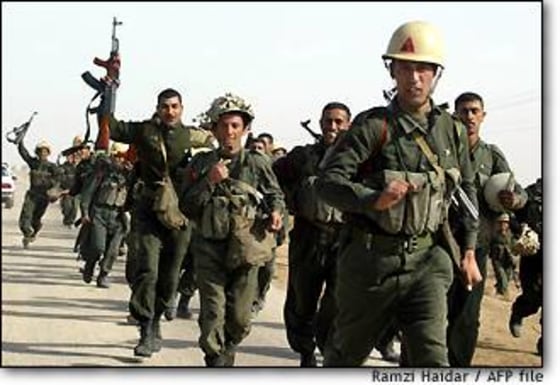They are Iraqi President Saddam Hussein’s crack troops — his first and last defense. The best trained, best equipped career soldiers whose loyalty has never been questioned.
THE AMERICAN military command has always warned that these six divisions of soldiers will be the toughest test of endurance the U.S. led coalition will have to face. After all, their allegiance to Saddam is partly rooted in blood ties: Many are recruited from his own tribe in his home town of Tikrit, to discipline the regular army — Saddam’s version of the S.S. Moreover, they are commanded by the president’s son, Qusay Hussein.
At least two Republican Guard divisions took a serious beating as U.S. forces charged toward Baghdad — the Medina Armored Division and the Baghdad Infantry Division. These troops probably knew they faced annihilation, but they fought anyway, in part, former American commanders who fought against them 12-years ago say, because they also paid better than regular soldiers to ensure their loyalty. Retired U.S. Army General Barry McCaffrey, who commanded the 24th Infantry Division in the Gulf War , says that “they are rewarded liberally in terms of cars and apartments and extra pay and better food, better equipment.”
OVERMATCHED
How do the Republican Guards stack up against United States troops in conventional warfare?
Gen. Norman Schwarzkopf commanded the attack on the Republican guard in the last Gulf War, and now also works as an NBC analyst.
“The good news is they don’t match up very well at all,” he said. “Their tank guns have a certain range to them, but our tank guns have a longer range.”
Dan Goure, a military analyst at the Lexington Institute in Washington who served in the Pentagon during the first Gulf War, agrees with this assessment. “The Republican Guard has been defeated in every direct combat with a competent adversary and they do not pose a threat to U.S. forces.”
FROM PALACE TO BATTLEFIELD
The Republican Guards trace their roots to a brigade of Palace Guards meant to protect Iraq’s president. In the 1980s, during the eight year long bitter Iran-Iraq war, Saddam expanded the Palace guards into separate forces of thirty to thirty-three brigades split into seven divisions. Many of them were young students from the President’s hometown, who were lured to volunteer to fight the Iranians.
And the crack troops lived up to Saddam’s expectations. Their tanks, mechanized infantry, and special forces did well in that conflict, acting as a reserve force that rushed to the front to repulse any breakthroughs by Iranian forces. By the end of the war, the Republican Guard had been anointed as Iraq’s primary offensive weapon.
Guard units are heavily equipped. According to globalsecurity.org, a military website, Guard battalions had 9 to 10 more tanks in them than regular army battalions, and always the best tanks available.
For Iraq, that meant locally produced versions of the Soviet T-72 main battle tanks, a formidable weapon when it was introduced in the late 1970s.
They also had the most modern equipment including Soviet BMP armored fighting vehicles, and took advantage of good relations with the west during the Cold War to stock up on French GCT self-propelled howitzers and Austrian GHN-45 towed howitzers.
TACTICAL STRENGTH
In spite of this, the Republican Guards units that encountered American and British forces during the first Gulf War took a beating. Air power claimed hundreds of their tanks, and when pitted against the American Abrams tanks, with their laser range finders and stabilized chassis, they proved no match.
Since then, thanks to 12 years of economic and military embargo, the relative advantages of U.S. forces have only increased.
(Lalita Aloor is an intern with international news at MSNBC.com)
